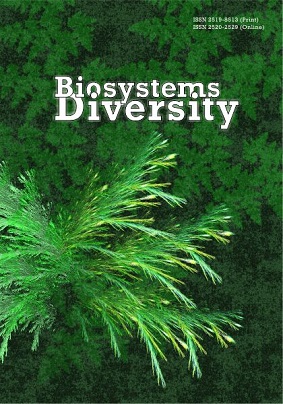Temporal dynamic of the phylogenetic diversity of the bird community of agricultural lands in Ukrainian steppe drylands
Temporal dynamic of the phylogenetic diversity of the bird community of agricultural lands in Ukrainian steppe drylands
Author(s): A. I. Koshelev, O. Y. Pakhomov, O. M. Kunakh, V. A. Koshelev, M.P. FedushkoSubject(s): Agriculture, Energy and Environmental Studies, Recent History (1900 till today), Human Ecology
Published by: Дніпропетровський національний університет імені Олеся Гончара
Keywords: diversity; Faith’s index; Rao’s quadratic entropy; overdispersion; stability; global climate changes; agroecology;
Summary/Abstract: This study discussed the importance of the phylogenetic components in the structure of bird communities of anthropogenically transformed ecosystems. The investigation was conducted in the landscapes of the south and south-east of Ukraine in the nesting seasons 1988–2018. The bird community in the agricultural landscape was found to be presented by 10 species. The number of species was closely correlated with its phylogenetic analogue – Faith’s index. Both indices were stationary over time, as they do not show a statistically significant time trend. The two axes were extracted as a result of the DPCOA procedure and the permutation test showed their statistical significance. The axis 1 was the most sensitive to the opposite dynamics of the abundance of Coturnix coturnix and Burhinus oedicnemus on the one hand and Alauda arvensis and Melanocorypha calandra on the other. The axis 2 is the most sensitive to the opposite dynamics of Corvus monedula and Melanocorypha calandra on the one hand and Coturnix coturnix and Motacilla flava on the other. Based on phylogenetic diversity, the years can be clustered with the extraction of four relatively homogeneous phylogenetic structures of bird communities. The indicator of the initial period of dynamics (1988–1992) was Burhinus oedicnemus. Sowing or mechanical weeding may be considered as a major factor of nest destruction of Burhinus oedicnemus. The decreasing of the abundance of the trophic recourses because of agricultural activity may have caused the monotonous negative trend over time of the Burhinus oedicnemus populations. The period 1993–2003 was a transitional one, for which there were no clear indicators, as a characteristic feature of this period was the processes of bird community restructuring. The period 2004–2013 was characterized by the loss of Burhinus oedicnemusfrom the community and a sharp increase in the abundance of Corvus monedula. These species are distinguished by their phylogenetic specificity and are located on the periphery relative to the phylogenetic core of the community. There was growing importance in the community of such species as Alauda arvensis, Anthus campestris, and Melanocorypha calandra between 2014 and 2018. Our results also confirm the assumption that phylogenetic overdispersion is an important requirement for the stability of the bird community in anthropogenically transformed landscapes.
Journal: Biosystems Diversity
- Issue Year: 28/2020
- Issue No: 1
- Page Range: 34-40
- Page Count: 7
- Language: English

